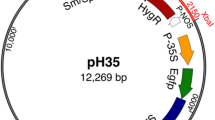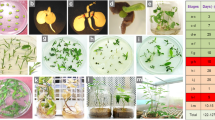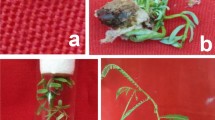Abstract
For pulse legume research to fully capitalise on developments in plant molecular genetics, a high throughput genetic transformation methodology is required. In Western Australia the dominant grain legume is Lupinus angustifolius L. (narrow leafed lupin; NLL). Standard transformation methodology utilising Agrobacterium tumefaciens on wounded NLL seedling shoot apices, in combination with two different herbicide selections (phosphinothricin and glyphosate) is time consuming, inefficient, and produces chimeric shoots that often fail to yield transgenic progeny. Investigation of hygromycin as an alternative selection in combination with expression of green fluorescent protein indicated that transformation of NLL apical cells was not the rate limiting step to achieve transgenic shoot materials. In this research it was identified that despite ready transformation, apical cells were not competent to regenerate. However a deep and broad wounding procedure to expose underlying axillary shoot and vascular cells to Agrobacterium, in combination with delayed selection proved successful, increasing initial explants transformation efficiency up to 75 % and generating axillary shoots with significant transgenic content. Based on knowledge gained from studies of plant chimeras, further subculture of these initial axillary shoots will result in development of low chimeric transgenic materials with heritable content. Furthermore, the method was also tested successfully on other Lupinus species, faba bea and field pea. These results demonstrate that development of a high yielding transformation methodology for pulse legume crops is achievable.







Similar content being viewed by others

Abbreviations
- Cc:
-
Co-cultivation medium
- CZ:
-
Central zone
- eGFP:
-
Enhanced green fluorescent protein
- GM:
-
Genetic manipulation;
- MPH:
-
Micropropagation medium with hygromycin
- NLL:
-
Narrow-leaf lupin
- Rg:
-
Regeneration medium
- PPT:
-
Phosphinothricin
- PZ:
-
Peripheral zone
- RZ:
-
Rib zone
- SAM:
-
Shoot apical meristem
- T0:
-
Initial generation of transgenic shoot
- T1:
-
Progeny of T0 generation
References
Atif RM, Patat-Ochatt EM, Svabova L, Ondrej V, Klenoticova H, Jacas L, Griga M, Ochatt SJ (2013) Gene transfer in legumes. In: Lüttge U, Beyschlag W, Francis D, Cushman J (eds) Progress in Botany. Springer, Berlin, pp 37–100
Atkins CA, Emery RJN, Smith PMC (2011) Consequences of transforming narrow leafed lupin (Lupinus angustifolius [L.]) with an ipt gene under control of a flower-specific promoter. Transgenic Res 20:1321–1332
Babaoglu M, McCabe MS, Power JB, Davey MR (2000) Agrobacterium-mediated transformation of Lupinus mutabilis L. using shoot apical explants. Acta Physiol Plant 22:111–119
Barker SJ, Si P, Hodgson L, Ferguson-Hunt M, Khentry Y, Krishnamurthy P, Averis S, Mebus K, O’Lone C, Dalugoda D, Koshkuson N, Faithfull T, Jackson J, Erskine W (2016) Regeneration selection improves transformation efficiency in narrow-leaf lupin. Plant Cell Tissue Org Cult. doi:10.1007/s11240-016-0992-7
Barton MK, Poethig RS (1993) Formation of the shoot apical meristem in Arabidopsis thaliana: an analysis of development in the wild type and in the shoot meristemless mutant. Development 119:823–831
Bowman JL, Eshed Y (2000) Formation and maintenance of the shoot apical meristem. Trends Plant Sci 5:110–115
Chien CT, Chen SY, Tsai CC, Baskin JM, Baskin CC, Kuo-Huang LL (2011) Deep simple epicotyl morphophysiological dormancy in seeds of two Viburnum species, with special reference to shoot growth and development inside the seed. Ann Bot 108:13–22
Evert RF (2006) Esau’s plant anatomy. Wiley, Hoboken
Fischer AH, Jacobson KA, Rose J, Zeller R (2008) Preparation of slides and coverslips for microscopy. CSH Protoc. doi:10.1101/pdb.prot4988
Iantcheva A, Mysore KS, Ratet P (2013) Transformation of leguminous plants to study symbiotic interactions. Int J Dev Biol 57:577–586
James C (2015) ISAAA Report on Global Status of Biotech/GM Crops. ISAAA Brief 51-2015, International Service for the Acquisition of Agri-biotech Applications (ISAAA), USA
Karami O, Esna-Ashari M, Karimi Kurdistani G, Aghavaisi B (2009) Agrobacterium-mediated genetic transformation of plants: the role of host. Biol Plant 53:201–212
Lazo GR, Stein PA, Ludwig RA (1991) A DNA transformation-competent Arabidopsis genomic library in Agrobacterium. Biotechnology 9:963–967
Lenhard M, Jürgens G, Laux T (2002) The WUSCHEL and SHOOTMERISTEMLESS genes fulfil complementary roles in Arabidopsis shoot meristem regulation. Development 129:3195–3206
Li H, Wylie SJ, Jones MGK (2000) Transgenic yellow lupin (Lupinus luteus). Plant Cell Rep 19:634–637
Maliga P, Nixon PJ (1998) Judging the homoplastomic state of plastid transformants. Trends Plant Sci 3:376–377
Mathews H, Wagoner W, Kellogg J, Bestwick R (1995) Genetic transformation of strawberry: stable integration of a gene to control biosynthesis of ethylene. In Vitro Cell Dev Biol Plant 31:36–43
Molvig L, Tabe LM, Eggum BO, Moore AE, Craig S, Spencer D, Higgins TJV (1997) Enhanced methionine levels and increased nutritive value of seeds of transgenic lupins (Lupinus angustifolius L.) expressing a sunflower seed albumin gene. Proc Nat Acad Sci USA 94:8393–8398
Murray JAH, Jones A, Godin C, Traas J (2012) Systems analysis of shoot apical meristem growth and development: integrating hormonal and mechanical signaling. Plant Cell 24:3907–3919
Nguyen AH, Wijayanto T, Erskine W, Barker SJ (2016) Using Green Fluorescent Protein sheds light on Lupinus angustifolius L. transgenic shoot development. Plant Cell Tissue Org Cult (accepted)
Pigeaire A, Aberneth D, Smith PMC, Simpson K, Fletcher N, Lu C-Y, Atkins CA, Cornish E (1997) Transformation of a grain legume crop (Lupinus angustifolius L.) via Agrobacterium tumefaciens mediated gene transfer to shoot apices. Mol Breed 3:341–349
Quétier F (2016) The CRISPR-Cas9 technology: closer to the ultimate toolkit for targeted genome editing. Plant Sci 242:65–76
Satina S, Blakeslee AF, Avery AG (1940) Demonstration of the three germ layers in the shoot apex of Datura by means of induced polyploidy in periclinal chimeras. Am J Bot 27:895–905
Sena G, Wang X, Liu H-Y, Hofhuis H, Birnbaum KD (2009) Organ regeneration does not require a functional stem cell niche in plants. Nature 457:1150–1154
Somers DA, Samac DA, Olhoft PM (2003) Recent Advances in legume transformation. Plant Physiol 131:892–899
Steeves TA, Sussex IM (1989) Patterns in plant development. Cambridge University Press, Cambridge
Sticklen MB, Oraby HF (2005) Shoot apical meristem: a sustainable explant for genetic transformation of cereal crops. In Vitro Cell Dev Biol 41:187–200
Sugimoto K, Gordon SP, Meyerowitz EM (2011) Regeneration in plants and animals: dedifferentiation, transdifferentiation or just differention? Trends Cell Biol 21:212–218
Szymkowiak EJ, Sussex IM (1996) What chimeras can tell us about plant development. Ann Rev Plant Physiol Plant Mol Biol 47:351–376
Tilney-Bassett RAC (1986) Plant chimeras. Edward Arnold Ltd, London
Tirichine L, Andrey P, Biot E, Maurin Y, Gaudin V (2009) 3D fluorescent in situ hybridization using Arabidopsis leaf cryosections and isolated nuclei. Plant Methods 5:11
Voss U, Larrieu A, Wells DM (2013) From jellyfish to biosensors: the use of fluorescent proteins in plants. Int J Dev Biol 57:525–533
Wijayanto T (2007) Genetic manipulation of programmed cell death (PCD) for reduced susceptibility to necrotrophic fungi in narrow-leafed lupin (Lupinus angustifolius). PhD Thesis, The University of Western Australia
Wijayanto T, Barker SJ, Wylie SJ, Gilchrist DG, Cowling WA (2009) Significant reduction of fungal disease symptoms in transgenic lupin (Lupinus angustifolius) expressing the anti-apoptotic baculovirus gene p35. Plant Biotechnol J 7:778–790
Wilms FHA, Sassen MMA (1987) Origin and development of floral buds in tobacco explants. New Phytol 105:57–65
Yeung ECT, Stasolla C, Sumner MJ, Huang BQ (eds) (2015) Plant microtechniques and protocols. Springer International Publishing, Cham
Acknowledgments
The first author acknowledges with deep gratitude the Australian Award Scholarship funded by the Australian Government. The authors acknowledge the facilities of CELLCentral, School of Anatomy Physiology & Human Biology, The University of Western Australia and the facilities, scientific and technical assistance of the Australian Microscopy & Microanalysis Research Facility at the Centre for Microscopy, Characterisation & Analysis (CMCA), The University of Western Australia, a facility funded by the University, State and Commonwealth Governments.
Author contributions
Project design and data analysis AHN, SJB and WE, transformations AHN and LH, plant tissue culture AHN, microscopy AHN, figure preparation AHN and SJB, manuscript preparation AHN, SJB, WE and LH.
Author information
Authors and Affiliations
Corresponding author
Rights and permissions
About this article
Cite this article
Nguyen, A.H., Hodgson, L.M., Erskine, W. et al. An approach to overcoming regeneration recalcitrance in genetic transformation of lupins and other legumes. Plant Cell Tiss Organ Cult 127, 623–635 (2016). https://doi.org/10.1007/s11240-016-1087-1
Received:
Accepted:
Published:
Issue Date:
DOI: https://doi.org/10.1007/s11240-016-1087-1



